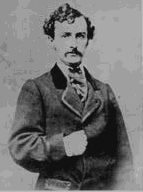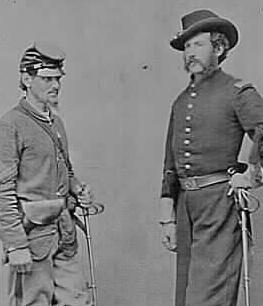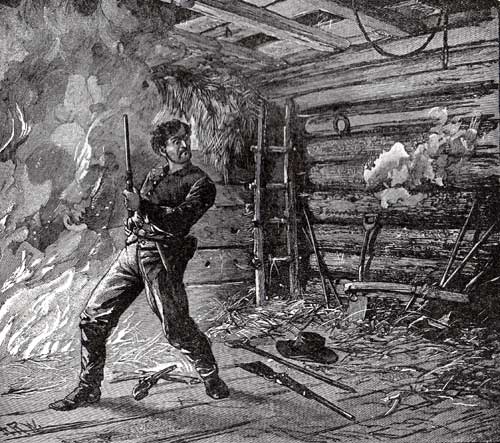JOHN WILKES BOOTH'S FINAL HOURS AND THE POSITIVE IDENTIFICATION OF HIS BODY |

John Wilkes Booth |

David Herold |
John Wilkes Booth and David E. Herold were sleeping in a tobacco barn owned by Richard H. Garrett on the morning of Wednesday, April 26, 1865, when Union cavalry finally caught up with them. In the vicinity of 2:00 A.M. the soldiers surrounded the barn which was located about 60 miles south of Ford's Theatre near Port Royal, Virginia. |
|
|
|
The Garrett house about 1865 (Theodore Roscoe photograph) and in the 1930's (National Park Service photograph). The house collapsed upon itself in the '30's.
|
|
 |
Lieutenant Luther Baker (a detective) yelled, "Surrender, or we'll fire the barn and smoke you out like rats! We'll give you five minutes more to make up your minds."
Booth asked for time to decide. Finally, after some more give and take with the soldiers, Booth yelled, "Well, my brave boys, you can prepare a stretcher for me! I will never surrender!"
Left: Library of Congress photo depicts Boston Corbett and Lieutenant Edward P. Doherty who commanded the Union cavalry that pursued Booth.
After a short time Booth said, "Oh, Captain, there's a man in here who wants to surrender awful bad." The barn door rattled, and David Herold's voice was heard saying he wanted to give up. Herold slowly came out and was slammed to the ground by the soldiers. He was hauled to a nearby tree and tied up with rope.
Still Booth would not come out. Using straw and brush detective Everton J. Conger set the barn on fire. Booth was visible to the soldiers because the barn was full of cracks and knotholes. They could see him moving about the burning barn holding his carbine and crutch (his left fibula being broken). |
|
|
Drawing by Alfred Waud |
|
Sketches from Civil War Times 'Album Illustrating the Assassination of Abraham Lincoln' |
At this point a soldier shot Booth through the neck. (CLICK HERE for information on Boston Corbett.) Booth's body was dragged out of the burning barn. For a short time the dying man was placed on the grass near a locust tree. Soon, though, the body was moved to the front porch of the Garrett home. Booth was paralyzed and barely alive.
With difficulty Booth was able to speak. He said, "Tell Mother I died for my country." He asked the soldiers to move his body to relieve the pain, but no position proved to be comfortable.
The image to the right comes from page 61 of The Escape and Capture of John Wilkes Booth by Dr. Edward Steers, Jr.
A local doctor, Dr. Charles Urquhart, Jr., who had been a physician in nearby Port Royal since 1821, arrived on the scene and indicated the wound which had punctured Booth's spinal cord was fatal. Sometime around 7:00 A.M. Booth looked at his hands and moaned, "Useless! Useless!" Those were the last words Booth spoke before dying. (It should be noted that Booth's final words vary from source to source.)
|
 |
|
Booth was pronounced dead at 7:15 A.M. A search of his body turned up a pair of revolvers, a belt and holster, a knife, some cartridges, a file, a War Map of the Southern States, a spur, a pipe, a Canadian bill of exchange, a compass with a leather case, a signal whistle, an almost burned up candle, pictures of five women - four actresses (Alice Grey, Helen Western, Effie Germon, and Fanny Brown) and his fiancée, Lucy Hale (the daughter of ex-Senator John P. Hale from New Hampshire), and an 1864 date book kept as a diary. CLICK HERE to read the text of the diary. To read an eyewitness account written by one of the cavalrymen present at Garrett's, CLICK HERE. |
Booth's body was sewn up in a horse blanket and placed on a wide plank which served as a stretcher. An old market wagon was obtained nearby, and the body was placed in the wagon. Using the wagon and later a steamer named the John S. Ide, Booth's body was returned to Washington. At 1:45 A.M., Thursday, April 27, Booth's body arrived at the Washington Navy Yard. There it was transferred to the deck of the ironclad Montauk. Within a short time, several people who knew Booth personally positively identified the body. One of these people was Dr. John Frederick May (1812-1891) who is pictured to the right. Some time prior to the assassination, Dr. May had removed a large fibroid tumor from Booth's neck. Dr. May found a scar from his operation on the corpse's neck exactly where it should have been. Charles Dawson, the clerk at the National Hotel where Booth was staying, identified the initials "J.W.B" pricked in India ink on the corpse's hand. As a boy Booth had his initials indelibly tattooed on the back of his left hand between his thumb and forefinger. |
|
Alexander Gardner, a very well known Washington photographer, was also among those who positively identified the remains of John Wilkes Booth as was Seaton Munroe, a prominent Washington attorney. The corpse was again positively identified in February of 1869 when Booth's remains were exhumed and released by the government to the Booth family. At that time an inquest was held at Harvey and Marr's Parlor in Washington. Booth's corpse was taken to Baltimore for burial and was positively identified by many people including John T. Ford, Henry Clay Ford, and Joseph Booth, John's brother.
The June 8, 1903, edition of the Alexandria Gazette contained an interview with Richard H. Garrett’s youngest son, Reverend Dr. Richard B. Garrett. The interview was titled "I SAW JOHN WILKES BOOTH KILLED." At the time of the interview Reverend Garrett was the pastor of the Court Street Baptist Church in Norfolk, Virginia. In the interview, Reverend Garrett said, “The slayer of President Lincoln died in my father’s barn. His remains were most thoroughly identified from a photograph and the printed description that was possessed by the soldiers. There is not the shadow of a doubt but that his wild life was ended by Sergeant Corbett’s bullet. I was there and was present at the identification. I know how thorough it was because it was the first intimation that my father had entertained for two days as his guest as an injured stranger in need -- the slayer of President Lincoln. I know how surprised we all were when it dawned upon us that the man lying dead before us could be no other than Booth. There were the tattoo marks of his initials on his arm, and the comparison with the picture was perfect. God never made two men exactly alike as the dead man and the one whose photograph there could be no doubt was Booth’s. Point by point the printed description held in the detective’s hand was followed out. Height, color of hair and eyes, every scar and mark tallied exactly. The crowning evidence of course, was the name of the actor done in India ink on his arm.”
|
|
For more on the positive identification of Booth's remains, see Francis Wilson's John Wilkes Booth. Also, Kennedy and Lincoln: Medical and Ballistic Comparisons of Their Assassinations by Dr. John K. Lattimer, The Great American Myth by George S. Bryan, and The Body In The Barn published by The Surratt Society are very definitive on the subject of positive identification. Another good source on the subject is the article entitled "Who Is Buried in Booth's Tomb?" by Joseph George, Jr. in the Winter 1994 edition of the Lincoln Herald. This is one of many fascinating articles contained in The Many Faces of Lincoln: Selected Articles from the Lincoln Herald edited by Charles M. Hubbard, Thomas R. Turner, and Steven K. Rogstad (Mahomet, Illinois, Mayhaven Publishing, 1997.) The photo of Dr. May came from Francis Wilson's book. For even more details on Booth's final hours, see the excellent article by Frederick Hatch entitled "Let Me Die Bravely" - The End of John Wilkes Booth in the August, 1998, edition of the Journal of the Lincoln Assassination.
The Garrett farmhouse is gone, but there is a historical marker very
close to the junction of Rt. 301 and Rt. 17. The marker is in the southbound lane of Rt. 301 across the street from Horne's Restaurant. The original location of the farmhouse is about 2.5 miles south of this marker (inside the boundaries of Ft. A.P. Hill). In the June 1990 edition of Blue & Gray magazine expert Michael Kauffman writes, "The Garrett house stood between the present northbound and southbound lanes of Route 301, about 50 yards south of the historical marker. The old barn, in which Booth was shot, was on the far side of the southbound lanes. No trace of it exists."
For much more information on Booth's final words please see the article entitled The Last Words of John Wilkes Booth...Or Were They? by Dr. Blaine V. Houmes in the June 2007 edition of the Surratt Courier.
Dr. Houmes also has written an interesting article on the relationship between Robert T. Lincoln, Abraham Lincoln's son, and Booth's fiancée, Lucy Hale. Please see "Robert Todd Lincoln, John Wilkes Booth, & Lucy Lambert Hale." Manuscripts, Vol. 59, No. 1, Winter 2007, pp. 5-11.
Booth's third, fourth, and fifth cervical vertebrae, which were removed during his autopsy, are currently housed (not on public display) at the National Museum of Health and Medicine at the Walter Reed Army Medical Center. An additional fragment from Booth's autopsy is in a bottle in the Mütter Medical Museum of the College of Physicians of Philadelphia.
In October 1994 a petition was filed in the Circuit Court for Baltimore City to exhume Booth’s remains from Green Mount Cemetery. The petitioners were people who identified themselves as Booth’s relatives. The cemetery argued that its solemn duty was to protect the sanctity of those interred unless there was overwhelming evidence that the body buried there was not Booth’s. Judge Joseph H.H. Kaplan ruled that the evidence for exhumation was insufficient. His 1996 decision was upheld by the Court of Special Appeals in Annapolis.
A new book was published in 2012. In the Footsteps of An Assassin is written and narrated by Michael W. Kauffman, author of American Brutus: John Wilkes Booth and the Lincoln Conspiracies. The richly illustrated book features a history of the assassination and Booth's escape. The tour section includes detailed maps, more photographs and an audio compact disc of Kauffman's narration. 164 pages, hard cover, spiral binding. For more information please CLICK HERE.
|

National Park Service Map Showing the Escape Route |
|










